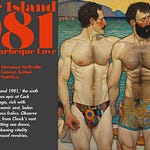If your images look strange and synthetic, then find a photographer who makes strange in and synthetic images. So this volume synopsis is a pairing of Thomas Pynchon and photographers Pierre et Gilles. As with prior volumes, it’s a synopsis of a roughly 250-page novel, covering our 8 characters as they take thir traditional summer vacation on Fire Island in the summer. The images, novel text, synopsis, anecdotes, the deep voiceover, everything is pure AI set within a series generated by AI, as well as the software which produced the content, thanks to a prompt matrix system I created, and animated from interaction with Open AI’s gpt-4o.
I couldn’t help but to love the work of Pierre et Gilles from the instant I saw them. I lived in Paris in the early 90’s, working for the Ministry of Culture, in a division of the Centre Pompidou called IRCAM (Institut de Recherche et Coordination Acoustique/Musique), and in the neighborhood (Les Halles, Centre Pompidou, Le Marais) I saw their images and I recall an exhibition (possibly at the bookstore/gallery Les Mots a la Bouche), and was hypnotized. There’s a tradition of 3-d lenticular images in the US, with posed puppet figures like Bambi, as well as the stop-motion film “Rudolph the Red-Nosed Reindeer” with elaborate sets, and photography combined with painting. Imagine then a couple of gay men composing images of, say, St Sebastian in such an artificial set, then in-painted with a background you might have seen in Volume 3 (Tintype). Of course, then you must take acid, get people as naked as possible and have a good time. Pierre et Gilles.
Strangely, I never fully achieved the full strangeness of Pierre et Gilles imagery, It’s probably the uniquity. David La Chappelle who comes up in a much later volume, gets much stranger, much of the imagery in this volume is conventionally handsome, lean young men a-la 1980’s New-Wave style. One nice thing with this duo, is that like the more modern artists, there is very little bias. Spontaneous European, African, Japenese men crop up, as well as Spanish, and (to my eyes) clearly Arabic men, and Russian/Caucus region men. Fascinating.
Dead-eye: these photos had probably the nastiest occurrence of dead-eye. Not the blank male-model stare, which is perfected in these, but eyes lacking directional focus, irises and quite bad looking at times. I left most of them in.
Beard Envy: These men while having the leanest most muscular bodies of all the series, they have spectacularly gigantic beards, the largest I’ve seen spontaneously generate. Here’s an example with slight dead-eye, and a beard that would make those with thin beard cry, flawlessly styled and effortless-looking. There’s a famous sequence of images depicting the evolution of man from more ‘primitive’ ancestors (which to me merely reflected an anti-Mediterranean Bias) “The Ascent of Man”. I had it in a book on Evolution as a child, and I was completely uninterested in “Modern Man”, and was quite interested in “Cro-Magnon” man - I wished I would meet one as an adult (I was 9).
Thomas Pynchon, of strange hieratic writing fame, worked fairly well as a style target for this exercise. It’s been a long time since I read “The Crying of Lot 49'“, full of mild paranoia, and strange coincidences, mysterious goings-on. The text is more “Gravity’s Rainbow” perhaps
In the hazy, throbbing heart of New York, under pulsating strobes and the hum of electric whispers, The Saint, a citadel of ecstatic unity and sensorial transcendence\u2014threw one final rapturous soiree. Cloaked in 1984's imminent twilight, the club's desperate, unrestrained celebration echoed an elegy for the forbidden margins, gloriously marking the end of an era awash with infernal euphoria and clandestine endeavors. This legendary sanctum, renowned for its exhilarating lesbian and gay revelries, exhaled its last breath as dawn's light fractured the sanctity of its sacred shadows.
This was a period of course when AIDS was hitting very hard across the spectrum of gay life in the US. I remember I was now old enough to go to gay bars, and conversations not infrequently trailed off into hoping that the ‘healthy lifestyle’ in LA was preventing the catastrophe enveloping New York, and San Franciso at the time. But of course, we all know the epidemic continued to grow for years and years. Sex became more… distant.
In the delirious haze of 1984, the iconic balladeers known as the Village People, ever the darlings of the disco inferno, unleashed their latest sonic exploration, 'Sex Over the Phone.' This audacious anthem, steeped in rhythms pulsating like neon heartbeats, reaffirmed their position as legendary fixtures within the vibrant and kaleidoscopic universe of lesbian and gay culture. With flamboyant flair and a cavalcade of contagious choruses, their opus shattered boundaries, echoing through the labyrinthine dancefloors and smoky haunts where liberation, wrapped in leather and lace, thrived unbridled.
I will have to reread Pynchon to see if his styling is a strong in the chapter, both in vocabulary and structure of flow as I expected. First pass it seems standard writing, though flamboyant
Chapter 4: Captain Finn, the Navigator of Nostalgia, unleashes a nocturnal quest beneath celestial alliances, unrolling age-worn maps with flamboyance, hinting at deeply personal treasures. Clad in pirate garb, the crew’s Tucker with his culinary antics, enigmatic Marco, and charming Pete dig through sands, not for gold, but uncovering intimate revelations under a lenient lunar gaze, finding kinship’s true fortune at dawn.
Waiting for a dawn in 1984.
Enjoy.















Share this post